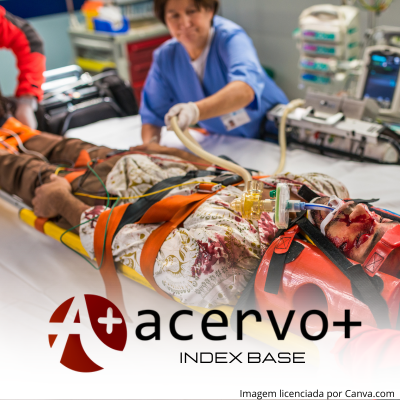Cuidados de enfermagem relativos à injúria renal no paciente politraumatizado
##plugins.themes.bootstrap3.article.main##
Resumo
Objetivo: Identificar na literatura os principais cuidados de enfermagem na identificação de manifestações clínicas, fatores de risco, prevenção e tratamento relativos à IRA no paciente politraumatizado. Métodos: Trata-se de uma revisão integrativa da literatura, de abordagem qualitativa, em que os dados foram buscados nas bases de dados: Literatura Latino-Americana e do Caribe em Ciências da Saúde, Medical Literature Analysis and Retrieval System Online e Cumulative Index to Nursing and Allied. Resultados: A partir da análise dos dados, foram identificadas 57.735 referências primárias, das quais, ao aplicar os critérios de inclusão, restaram 1.572 documentos completos. Em seguida, foi realizada a leitura dos títulos e resumos, resultando em 72 estudos para leitura na íntegra, dos quais 18 contemplaram o objetivo da pesquisa. Considerações finais: Este estudo abordou premissas essenciais na assistência de enfermagem em terapia intensiva, de modo a contribuir com a prevenção da morbidade e mortalidade atreladas à IRA, através da identificação precoce, medidas de precaução e intervenções terapêuticas.
##plugins.themes.bootstrap3.article.details##
Copyright © | Todos os direitos reservados.
A revista detém os direitos autorais exclusivos de publicação deste artigo nos termos da lei 9610/98.
Reprodução parcial
É livre o uso de partes do texto, figuras e questionário do artigo, sendo obrigatória a citação dos autores e revista.
Reprodução total
É expressamente proibida, devendo ser autorizada pela revista.
Referências
2. BEITLAND S, et al. Primary injuries and secondary organ failures in trauma patients with acute kidney injury treated with continuous renal replacement therapy. Scientifica (Cairo), 2014; 2014: 1-6.
3. BOSCO DD, et al. Acute kidney injury in severe trauma patients; a record-based retrospective study. Adv J Emerg Med., 2019; 3(3): 1-6.
4. COELHO FUDA, et al. Nursing Activities Score e a lesão renal aguda. Rev Bras Enferm. 2017; 70(3): 475-480.
5. GOYAL A, et al. Acute kidney injury. In: StatPearls. Treasure Island (FL): StatPearls Publishing; 2022.
6. GRASSI MDF, et al. Diagnósticos, resultados e intervenções de enfermagem em pacientes com lesão renal aguda. Acta Paul Enferm., 2017; 30(5): 538-545.
7. HATTON GE, et al. Choice of reference creatinine for post-traumatic acute kidney injury diagnosis. J Am Coll Surg., 2019; 229(6): 580-588.
8. HATTON GE, et al. Importance of duration of acute kidney injury after severe trauma: a cohort study. Trauma Surg Acute Care Open, 2021; 6(1): 1-6.
9. KO CH, et al. Effects of Mean Artery Pressure and Blood pH on Survival Rate of Patients with Acute Kidney Injury Combined with Acute Hypoxic Respiratory Failure: A Retrospective Study. Medicina (Kaunas), 2021; 57(11): 1-14.
10. LAI WH, et al. Post-traumatic acute kidney injury: a cross-sectional study of trauma patients. Scand J Trauma Resusc Emerg Med., 2016; 24(1): 1-7.
11. LAMEIRE NH, et al. Harmonizing acute and chronic kidney disease definition and classification: report of a Kidney Disease: Improving Global Outcomes (KDIGO) Consensus Conference. Kidney Int., 2021; 100(3): 516-26.
12. LEDITZKE K, et al. Neutrophil Gelatinase-associated Lipocalin Predicts Post-traumatic Acute Kidney Injury in Severely Injured Patients. In Vivo, 2021; 35(5): 2755-62.
13. LEVEY AS, et al. Nomenclature for kidney function and disease: report of a Kidney Disease: Improving Global Outcomes (KDIGO) Consensus Conference. Kidney Int., 2020; 97(6): 1117-1129.
14. LI O, et al. Gene microarray integrated with high-throughput proteomics for the discovery of transthyretin in rhabdomyolysis-induced acute kidney injury. Cell Physiol Biochem., 2017; 43(4): 1673-1688.
15. MENDES KDS, et al. Uso de gerenciador de referências bibliográficas na seleção dos estudos primários em revisão integrativa. Texto Contexto-Enf., 2019; 28: 1-13.
16. MO S, et al. Acute kidney injury in intensive care patients: Incidence, time course, and risk factors. Acta Anaesthesiol Scand., 2022; 66(8): 961-968.
17. NEGRIN LL, et al. Diagnostic utility of serum neutrophil gelatinase-associated lipocalin in polytraumatized patients suffering acute kidney injury: a prospective study. BioMed research international, 2018; 2018: 1-11.
18. QI F, et al. Endothelial glycocalyx degradation is associated with early organ impairment in polytrauma patients. BMC Emerg Med., 2021; 21: 1-10.
19. ROMANO TG e TIERNO PFGMM. Injúria Renal Aguda no paciente politraumatizado. Braz J Nephrol., 2013; 35(1): 48-56.
20. SANTOS RPD, et al. An epidemiologic overview of acute kidney injury in intensive care units. Rev Assoc Med Bras., 2019; 65(8): 1094-101.
21. YANG SY, et al. Nomenclature and diagnostic criteria for acute kidney injury–2020 consensus of the Taiwan AKI-task force. J Formos Med Assoc., 2022; 121(4): 749-765.
22. YOU B, et al. Late-Onset Acute Kidney Injury is a Poor Prognostic Sign for Severe Burn Patients. Front Surg., 2022; 9: 1-10.
23. ZAND F, et al. Early acute kidney injury based on serum creatinine or cystatin C in intensive care unit after major trauma. Iran J Med Sci., 2015; 40(6): 485-492.
24. ZHANG H, et al. Influencing Factors and Prevention of Sepsis or Acute Kidney Injury in 85 Patients with Severe Trauma. Evid Based Complement Alternat Med., 2021; 2021: 1-7.

